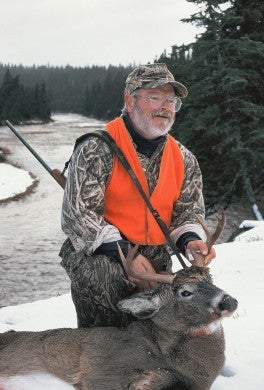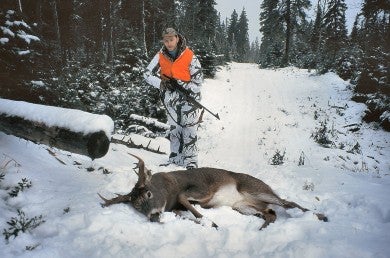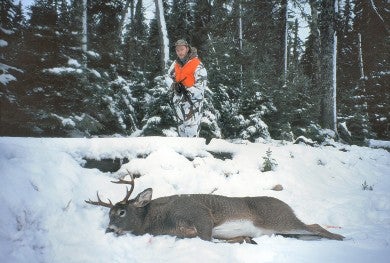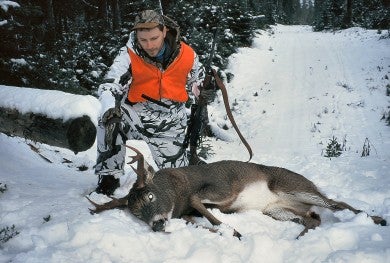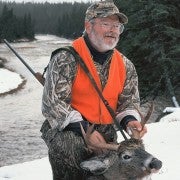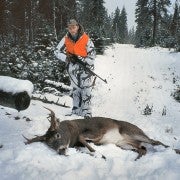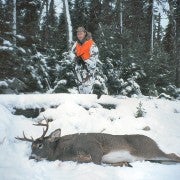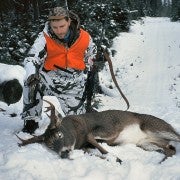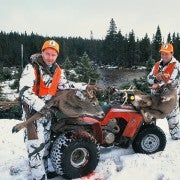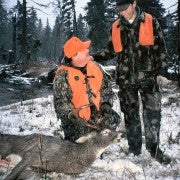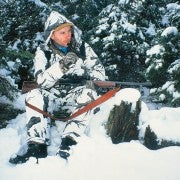Anticosti Island Bucks
Bob McNally 02.27.14
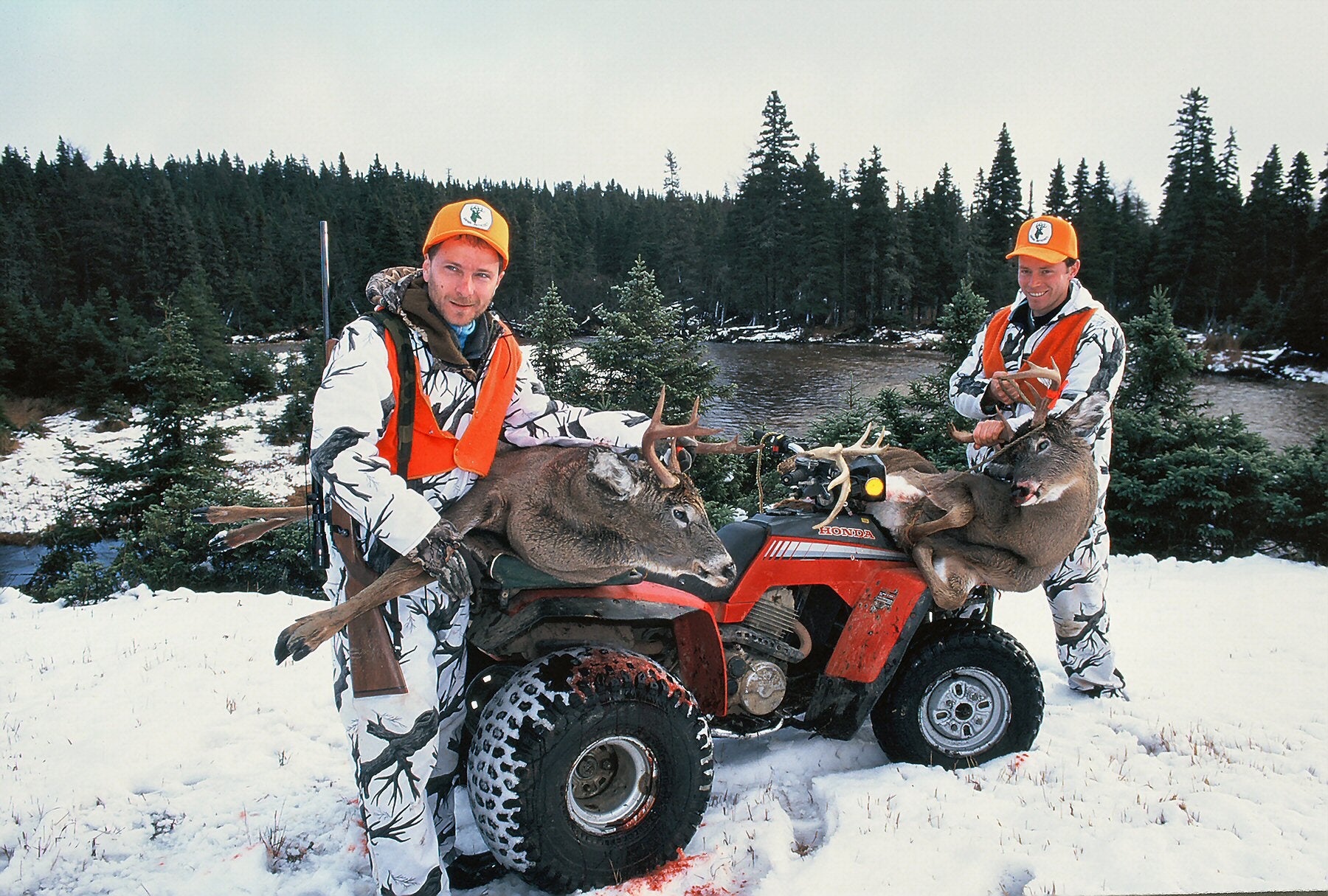
Rattling antlers cracked loudly, and the follow-up tinkling of tines sounded crisp and appealing as they resonated through dark-green, snow-blanketed timber that cold morning. Siegfried Gagnon of Montreal and I stood motionless, almost daring not to breathe, as we listened intently in the quiet, white-green Quebec woods, hoping for a deer response to the clattering of antlers I’d made.
We waited a few moments, then I slammed the antlers together once again, following with a grinding of tines to simulate a pair of hard-headed bucks battling over a love-minded doe. It was the peak of the rut on famed, deer-rich Anticosti Island, located in the Gulf of St. Lawrence in far northeastern Quebec. And on this, the second day of our already successful hunt, conditions were perfect for stalking and rattling the abundant bucks on the large, heavily-wooded, north-country island.
Our guide, Claude Isabellele, and our other hunting companion, D’Arcy Egan of Cleveland, had dropped Siegfried and I off that morning on a snowy woods road. While Claude guided D’Arcy to another hunting spot, Siegfried and I were instructed to follow the woods road for a mile before we separated and hunted down different, well-marked, snow-covered trails.
The wind was perfectly in our faces, and new snow made for silent stalking. For an hour we still hunted, stopping every few minutes to rattle antlers and grunt call, and then we sat, watched, and listened for bucks, which we knew were aroused and moving about. For two days, bad weather had plagued Anticosti, though rutting bucks were still very much on the move, looking for does in the driving sleet-rain-snow weather. With a break in the storm, it was likely every mature buck that could would be on the prowl prospecting for receptive does.
During the first hour of our hunt, Siegfried and I saw nothing except numerous sets of fresh deer tracks that crossed the quiet open lane that snaked through rolling balsam and fir forests that makes up most of Anticosti. Each time we discovered a large set of tracks, we’d stop and grunt, rattle antlers, and watch the surrounding, dense woods for signs of an approaching buck.
Finally, after rattling and grunting during one stop where we’d found particularly large and fresh tracks, Siegfried suddenly became alert.
“I just saw a deer cross the lane far ahead, 150 yards or so,” he whispered in his thick French accent. “I don’t know if it was a buck, but it was a deer for sure, a big one!”
I grunted again, and we watched, but nothing happened.
Then I rattled antlers. Still nothing.
With the wind in our face, we stalked ahead slowly, quietly, and carefully tight to the side of the woods lane. We took full advantage of our head-to-foot snow camouflage, which blended in perfectly with the white-shrouded woods. We wore blaze orange vests to abide by Quebec hunting law, but the bulk of our silhouettes were one with the snowy forest. Fifty yards farther up the snow-covered lane, I rattled antlers again. Nothing. Then I grunted.
“There! There’s a deer, but I think it is only a doe,” Siegfried said, as we both instinctively knelt, tight to the road-side trees for better camouflage.
Out about 100 yards, a deer head materialized from the woods. Then, slowly, it stepped completely into the open timber lane. I raised my scoped rifle and quickly determined the good-size deer was a buck, which now stood broadside.
“It’s nice six-pointer, I think,” I whispered quietly to Siegfried while analyzing the deer’s rack. “I’m not going to shoot because I’ve already got a bigger buck this trip, and I want to hold out for an even better one.”
“I will not shoot then, either,” said Siegfried as he raised his rifle to look over the deer with his scope. I already have a 6-pointer, too.”
Through my scope in the clear, bright, morning sun, I could see the deer was completely at ease. Its swollen neck and indifference to being entirely exposed in bright sunlight left little doubt he was in full rut. It was a healthy, mature whitetail, but since neither Siegfried nor I were going to shoot, I thought it would be fun to play with him. Carefully I reached down, grabbed my grunt call hanging around my neck on a lanyard with one hand while still holding the rifle on the deer to watch it through my scope. Pressing the call to my mouth I made a series of soft grunts. Instantly the buck turned and took several steps toward us.
“Ooh, he’s bigger than I thought,” I whispered to Siegfried, scrutinizing the deer’s rack through the optics as he faced us, walking slowly closer. “He’s at least a seven-pointer, and the rack is wider than I first noticed.”
Siegfried and I watched through our rifle scopes in amazement as the buck continued walking directly toward us. Periodically he’d stop and stare, especially when I’d grunt softly while we remained as still as the balsam trees we pretended to be. At 75 yards, the buck turned its head slightly and I got a good point count of the rack.
“He’s an eight, not a seven-pointer,” I whispered in my most quiet hunting tone while being watched by a good buck.
“He’s a seven,” Siegfried countered just as the deer walked down into a low spot in the lane, with now only his antlers visible from our crouched position.
“No, he’s an eight!……a nice eight!!”
“In that case, I may have to change my mind and shoot him,” Siegfried said quickly.
“You better decide soon. When he comes up out of that low spot he’ll only be 40 yards, and you better bust him before he sees us and spooks. Believe me, he’s an eight-pointer, I can see all of his tines clearly right now.”
Slowly, methodically, the buck climbed out of the woods lane swale, closing the distance between us until he came into full view. He stared directly at us, never knowing anything was out of the ordinary until Siegfried touched his rifle trigger and the buck collapsed in its tracks – 31 steps from where we crouched. It was an eight-pointer and Siegfried’s best-ever buck, weighing an estimated 160-pounds. We were elated, not only about the size and quality of the buck, but the manner in which we’d taken him. Rare is it to witness grunt calling work so well on a buck, and it’s rarer still to enjoy such an outstanding hunting event with a good friend kneeling at your side.
By the time we field dressed the buck and made photos of Siegfried and his deer, it was noon, and Claude and D’Arcy returned in the camp truck for our mid-day rendezvous. They, too, had been successful, with D’Arcy downing an equally nice eight-pointer.
While Anticosti has never had a Boone and Crockett buck taken from it, island deer are heavy, healthy, and their racks are typical of big-woods, north-country whitetails. The deer look much like what one would expect of nice bucks taken in upstate New York or northern Wisconsin or Michigan. Mature bucks typically weigh 150 to 180 pounds, but most importantly, the number of good-size whitetails on the island is truly amazing.
For example, we arrived at Anticosti the night of the second day of a scheduled four-day deer hunt. Hunters are rotated out every four days, but we had been delayed by weather and missed the first half of the hunt. When we arrived in camp, we were taken to a large walk-in cooler to view what the other sportsmen already had taken during the previous two days, and it was a remarkable sight. There were 16 hunters in camp (in addition to us), and there is a two deer limit on Anticosti.
Hanging in the camp cooler were 28 bucks, and every one of them was a good deer, every one. There were none less than six points, and only two of those were not basket racks. Rather, the six-pointers had wide main beams and good mass.
The bulk of the bucks were eight-, nine-, and 10-pointers, and there were many 10s, including some real dandies. They were deer any hunter would be proud to tag anywhere whitetails roam. Moreover, the few hunters who had not taken their second buck (everyone had shot at least one deer) were holding out for a larger trophy to finish their hunt.
